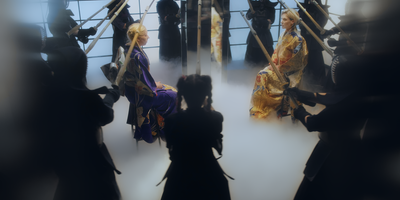
2021 | Fiction | 10 min. | Russia | 12+
Sometimes, in order to see oneself, one needs to have a look from a different angle. This movie is the story of three women - a grandmother, a mother, and a granddaughter, who are preoccupied with themselves and do not hear each other. But if we look at them through the prism of the Playing Japan, what shall we see? - The loneliness that can be overcome.
Directors Statement
Transcendental Movie Card – To Die in the Japanese Garden: The action takes place in a universe where everyone plays Japan, where the world is a theater, and where its rules, conditions, and laws are perceived as the norm. The grandmother is on the verge of inevitable death has only one desire, allegorically expressed by strives for spiritual silence. Her small family comprised of her daughter and granddaughter wants to fulfill this desire, by placing itself in an atmosphere of a tea ceremony led by the Spirit of Japan, who can take a human being into the world of a higher order. The beginning of the tea ceremony, which starts with cleansing of a teaspoon that the viewer observes, is meditation, cleansing of thoughts, tuning to the communication channel with God. This act in the ceremony was specifically invented by the Japanese monks for the purpose of meditating. In fact, the entire tea ceremony in Japanese culture and history can be compared in its significance with the church services of the Orthodox, with communal prayers in Synagogues, Mosques, or meditative practices of Indian yogis. But after the family leaves the grandmother on her deathbed, they plunge into their own discords associated with the fact that the Mom dates a husband of a respected doctor. Rumors fly quickly in a community, where the heroes live, and the girl experiences deep moral sufferings caused by her mother's behavior. Having reached the limits of her emotional torments, the girl gets immersed in her own imagination, in which she gets bullied by her classmates, whom she defeats by telekinetic powers and ability to reverse the course of time. The scene, where the Mom meets with a husband of a respected doctor demonstrates that in this universe no one can touch each other because of the different degrees of moral density of the body mass. This raises the question if everyone present is alive at all? And what do the last hugs of the grandma's signify? The pulsation of the phone resembles the rhythm of the breathing of an aroused person. The Girl and Mom scene shows the static character of the universe when there is no movement in it. It also shows that only the action or presence of two or more objects in space can lead to life. The rest of the time, these objects are just puppets, which are similar to parked cars. All these actions distracted the grandmother and did not let her experience inner silence and peace during her last breath. The final scene is a map of the place where the world of higher and the world of lower order meet together. The Mirror Drum is a visualized transformation of the grandmother's soul after 9 days from her death. Mom and daughter communicate with each other within the 13-hour time scale of the proposed universe. In fact, this scale is just another way to demonstrate the boundaries of time and a reminder that one can step beyond the limits of time. But this understanding is granted only to the viewer, who watches the scene from a higher scale. The actions of the Mom and the daughter distorted the inner silence and did not let it manifest at the last breath of the grandmother. This is neither good nor bad; this is just the fact of how it is.
Director: Ruslan Yankovsky
Producer: Ruslan Yankovsky
Сast: Roza Khairullina and Inna Yarmoshuk









